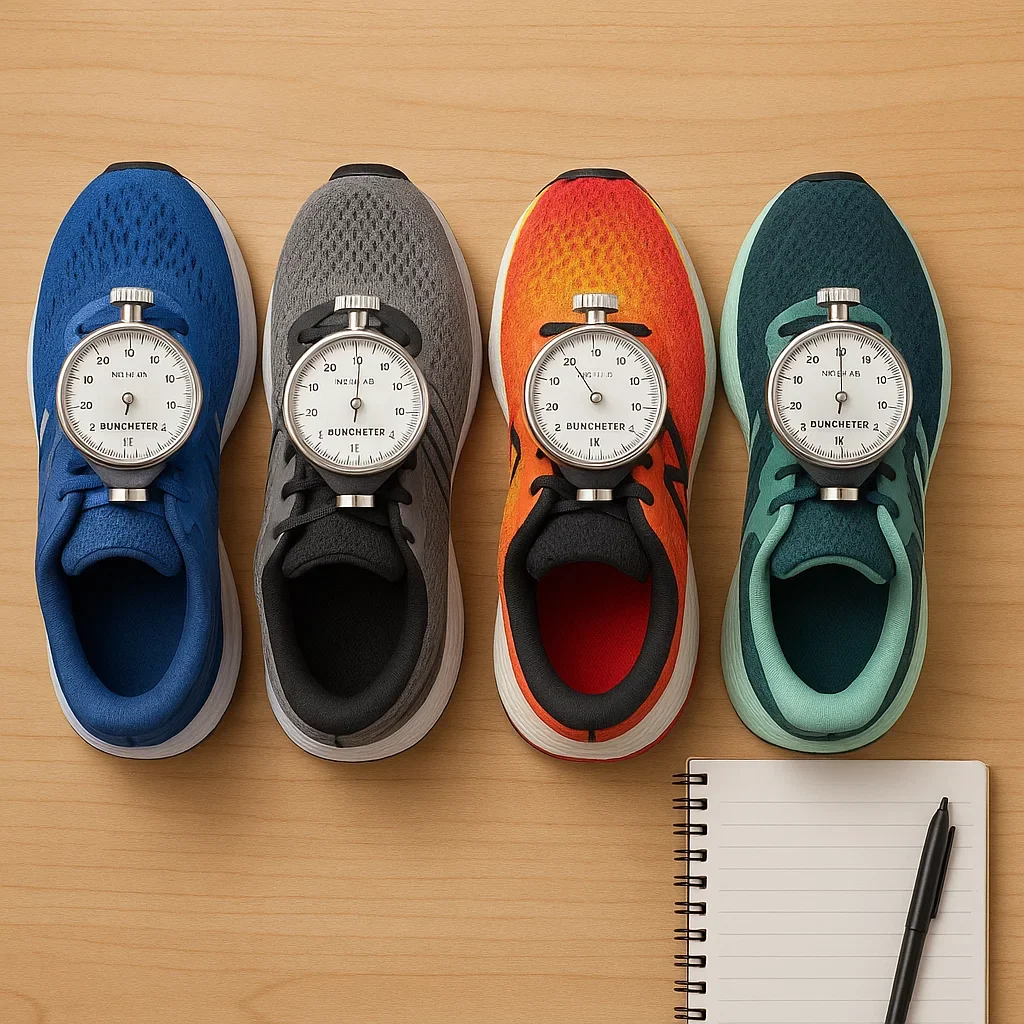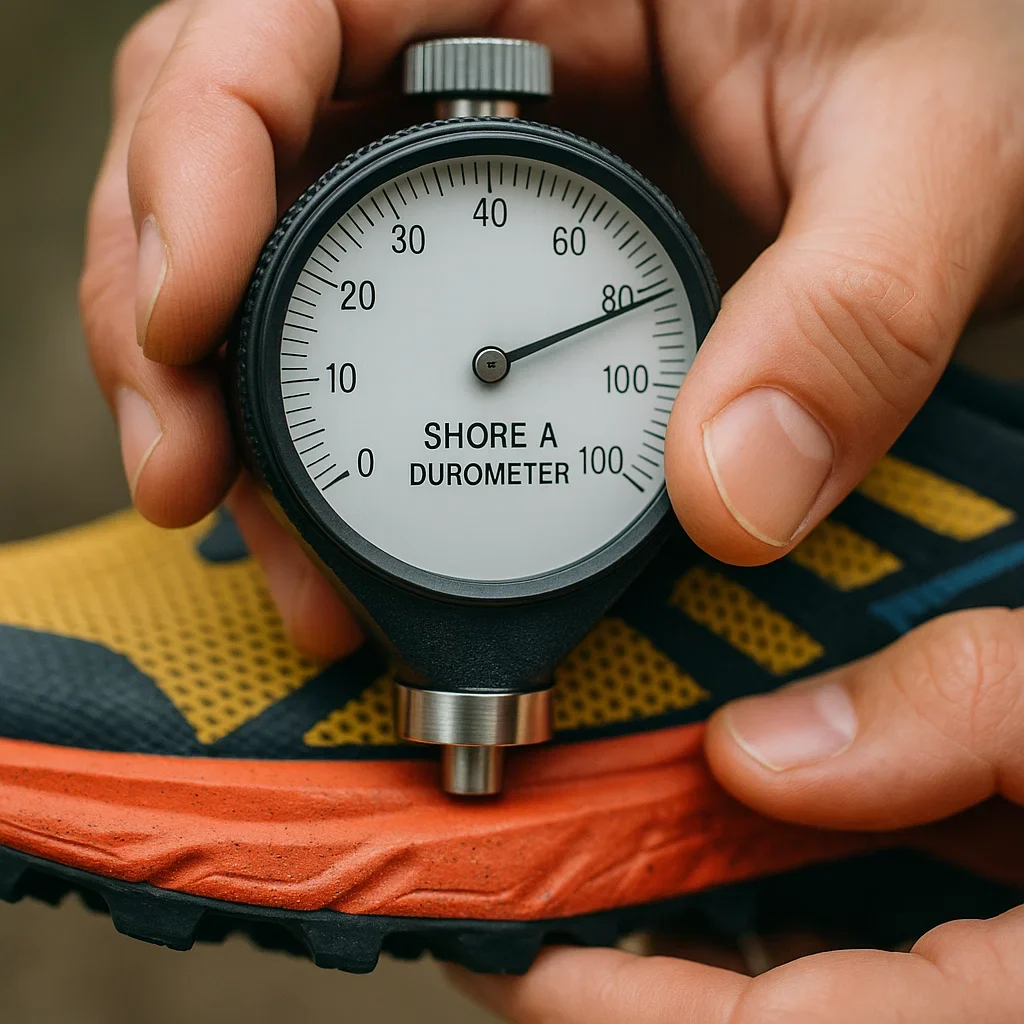🪛 Measure Midsole Hardness With a $20 Shore-A Durometer
Introduction
Have you ever wished you could objectively compare how “dead” or “alive” your running shoe foam really is?
A Shore-A durometer is a simple tool—think of it as a “hardness meter” for foams and rubbers—that gives you a clear, numerical answer. For about $20, you can measure how your shoe’s midsole ages, compare models, and make smarter decisions about when to retire or rotate your gear. No more guessing, no more “it just feels flat.”
Let’s walk through everything you need to know—even if you’ve never held a durometer before.
What is a Shore-A Durometer?
A durometer is a small, spring-loaded gauge that measures the hardness of soft materials, especially rubbers, plastics, and—you guessed it—shoe foams.
- Shore-A is the most common scale for midsoles. (There’s also Shore-C and Shore-D, but those are for harder materials.)
- The number (0–100) represents how much the material “gives” when pressed:
- Low numbers = soft, bouncy, squishy.
- High numbers = firm, stiff, less cushioning.
When you press a durometer into your shoe’s midsole, it gives you a number right away.
- A brand-new superfoam like PEBA might read 30–40 Shore-A.
- Firmer, traditional EVA foams often measure 45–55 when new.
- “Dead” or aged foam can climb up to 60+, meaning less cushion remains.
Why Bother Measuring Hardness?
1. See the invisible aging:
Foams can feel fine but still lose a ton of softness, especially if you’re a light runner or rotating multiple shoes.
2. Compare brands and models:
Maybe your favorite Hoka and Altra feel similar, but durometer shows one stays softer after 400km.
3. Detect “dead shoe syndrome” early:
A sudden jump of 10+ points in Shore-A means your foam is toast—even if the outsole looks fine.
4. Build your own “hardness log”:
Track how quickly (or slowly) different shoes lose their bounce. Over time, you’ll know exactly which brands really last.
How to Use a Shore-A Durometer on Your Running Shoes
What You Need
- A Shore-A durometer (digital or analog, both work; cheap ones from AliExpress or Amazon are fine)
- The shoe you want to test (remove insole for best accuracy)
- A firm, flat table
- Pen and notebook (or your phone) to record numbers
Step-by-Step
1. Make sure the shoe is at room temperature and dry.
Cold or wet foam reads artificially hard or soft!
2. Choose your measurement spot.
- Most runners test the center of the heel and the ball of the forefoot.
- Avoid outsole lugs or any exposed rubber—just the midsole foam.
3. Press the durometer firmly and smoothly into the foam.
- Hold for 1–2 seconds.
- If you have a digital model, just read the number.
- If analog, check where the needle lands.
4. Take 2–3 measurements at each spot and average the results.
5. Log your numbers:
Write down: Shoe, date, mileage, heel Shore-A, forefoot Shore-A.
Pro tip: For even more accuracy, cut a small hole in an old insole to insert the durometer through the sockliner, mimicking real in-shoe conditions.
What Do the Numbers Mean?
- 30–40 Shore-A: Very soft, “superfoam” feel. Most carbon-plated racers start here.
- 40–50 Shore-A: Typical of daily trainers when new.
- 50–60 Shore-A: Aging foam; noticeably firmer and less bouncy.
- 60+ Shore-A: “Dead” shoe territory for almost all runners.
What’s normal?
Most shoes will gain 5–10 points in Shore-A after 300–600km.
If you see a sudden jump (e.g., from 45 to 55 in a few months), that’s a sign your foam is wearing out fast.
Real-World Examples
- Lost Pace’s Hoka Rincon:
- New: Heel 41, Forefoot 39
- After 400km: Heel 47, Forefoot 44
- At 700km: Heel 53, Forefoot 50 (Started feeling dead. Matched compression test.)
- Nike ZoomX Invincible:
- New: Heel 33
- At 350km: Heel 41
- At 600km: Heel 47 (But still softer than most shoes ever get!)
- Heavy runner, Asics FujiTrabuco:
- New: 45
- At 350km: 57 (High wear, compressed feel.)
Takeaway: The higher the durometer, the firmer and less shock-absorbing the foam.
But every brand and foam type is a little different—use YOUR log for the best results.
Troubleshooting & Tips
- My numbers change each time!
Don’t worry—soft foams vary a bit. Always test at the same temp, spot, and time of day for consistency. - Can I use this on road shoes, too?
Yes, this method works for all running shoes with exposed foam midsoles. - Is a cheap durometer accurate?
For comparisons and tracking trends, yes. (Lab-grade is nice, but overkill for most runners.) - What about carbon plates or thick outsoles?
Try to test areas away from plates or non-foam inserts. - Can I “reset” a hard midsole?
No—once the foam hardens with use, it doesn’t come back.
When Should I Replace My Shoes, Based on Durometer?
A good rule of thumb:
- When your shoe’s midsole reads 10 points higher than when new, start thinking about replacement.
- If it hits 60+ Shore-A or feels dead, definitely retire it for running—use it for walking or yard work instead!
If you also measure midsole compression (see B1 guide!), combine both data points for a rock-solid decision.
Final Thoughts
Using a durometer puts real numbers behind your running shoe choices. You’ll be able to spot “dead shoes” early, compare brands, and get the most from your gear.
Data beats guesswork—happy measuring!
❓ Frequently Asked Questions (FAQ)
🪛 1. What is a Shore-A durometer and how does it work?
A durometer is a small, spring-loaded tool that measures the hardness of soft materials. Shore-A is the scale used for shoe foams. Press it into your shoe’s midsole—the higher the number, the firmer (and less cushioned) the foam.
📏 2. Do I need an expensive durometer for this test?
Nope! A $15–$25 model from AliExpress or Amazon works great for tracking trends and comparing shoes. Lab-grade precision is only needed for scientific research.
👟 3. Where should I measure the foam on my shoe?
Test the center of the heel and the ball of the forefoot—avoid outsole rubber, logos, or plates. Always test the same spots for accurate tracking.
🌡️ 4. Does temperature affect the results?
Yes! Foam gets firmer in cold and softer in heat. Try to test at a consistent room temperature for best comparisons.
📝 5. How often should I check midsole hardness?
Every 100–200 km is ideal, or whenever your shoe feels different. More often if you’re a heavier runner or racing frequently.
🔢 6. What’s a “normal” durometer reading for new trail shoes?
New trail shoes usually start at 35–45 Shore-A for soft foams, 45–55 for firmer ones. Every brand and model is a bit different!
🔄 7. How much should the hardness change before I worry?
If your shoe’s durometer reading goes up by 10+ points compared to new, or you’re hitting 60+ Shore-A, it’s time to consider replacement.
✍️ 8. Why do my results vary test to test?
Likely causes: different spots, angle, or shoe temperature. Always use the same location, time, and method for consistency.
🦶 9. Is this useful for road shoes too?
Yes! The method works for any running shoe with exposed foam—trail, road, even racing flats.
📉 10. Can I use durometer readings along with compression tests?
Absolutely. Combining both gives you the clearest picture of foam “health” and when to retire shoes.
📊 11. What if two shoes with the same mileage have different readings?
Foams, brands, and user weight all make a difference. That’s why logging your data matters more than comparing to others!
💡 12. Can I test shoes with plates or inserts?
Try to test only exposed foam, not on or near carbon plates or thick rubber patches. Otherwise, you’ll get false high readings.
🔬 13. What does a “hard” number really feel like underfoot?
Shoes above 60 Shore-A will feel noticeably firmer, less cushioned, and more “slappy” on impact.
🔗 14. Where can I share my results or see others’?
Try Reddit (r/RunningShoeGeeks), trail/ultra forums, or Strava gear notes. Sharing your data helps the whole community!
🧼 15. Does cleaning or wet weather affect readings?
Always test on dry, room-temperature shoes—wet foam can read artificially soft.
🛍️ 16. Should I bring a durometer when buying new shoes?
Why not! Some savvy runners do just that—especially if comparing in-store models side by side.
👟 17. Can I revive a hardened midsole?
Sadly, no. Once the foam “creeps” and hardens, there’s no way to bring it back.
📅 18. Will durometer readings help me avoid injury?
Indirectly, yes—firmer, dead foams absorb less shock, raising the risk of fatigue and injury. Knowing when to replace helps you stay healthy.
🎨 19. Is there a difference in readings for colored vs. white foam?
Color itself doesn’t matter, but different foams (even within the same shoe) can have different durometer readings. Test each main area!
📝 20. How do I log my durometer readings?
Use a notebook or spreadsheet: track shoe, mileage, date, heel/forefoot readings. Over time, you’ll spot clear trends!
📚 Further Reading
External (authoritative sources):
- Long-term Performance Change of Running Shoes (ResearchGate)
(Academic study of running shoe aging, including foam hardness data) - Cushioning Properties of Running Shoes (PubMed)
(Peer-reviewed, midsole performance and injury research) - How to Measure Running Shoe Hardness (YouTube)
(DIY videos and test techniques)
📝 Quiz – Test Your Knowledge
1. What does a Shore-A durometer measure in running shoes?
a) Outsole grip
b) Midsole hardness
c) Waterproofness
d) Color
2. At what durometer reading do most runners consider a shoe “dead”?
a) 30
b) 40
c) 60+
d) 80
3. Where should you press the durometer on your shoe for consistent results?
a) Over the logo
b) On the outsole
c) Center of heel and forefoot foam
d) The tongue
4. Why should you always measure at room temperature?
a) It’s more comfortable
b) Foam hardness changes with heat and cold
c) Shoes look better
d) It doesn’t matter
5. What’s a smart next step if you see a sudden jump in durometer (e.g., 45 to 60) before expected mileage?
a) Ignore it
b) Start tracking more often and consider rotating shoes
c) Clean the shoe
d) Only test on rainy days
Quiz Answers:
1: b) Midsole hardness
2: c) 60+
3: c) Center of heel and forefoot foam
4: b) Foam hardness changes with heat and cold
5: b) Start tracking more often and consider rotating shoes


About the Author
Lost Pace is an ultramarathon runner, shoe-tester and the founder of umit.net. Based year-round in Türkiye’s rugged Kaçkar Mountains, he has logged 10,000 + km of technical trail running and completed multiple 50 K–100 K ultras.
Blending mountain grit with data, Lost analyses power (CP 300 W), HRV and nutrition to craft evidence-backed training plans. He has co-written 260 + long-form guides on footwear science, recovery and endurance nutrition, and is a regular beta-tester of AI-driven coaching tools.
When he isn’t chasing PRs or testing midsoles, you’ll find him sharing peer-reviewed research in plain English to help runners train smarter, stay healthier and finish stronger.
Ultrarunner · Data geek · Vegan athlete

